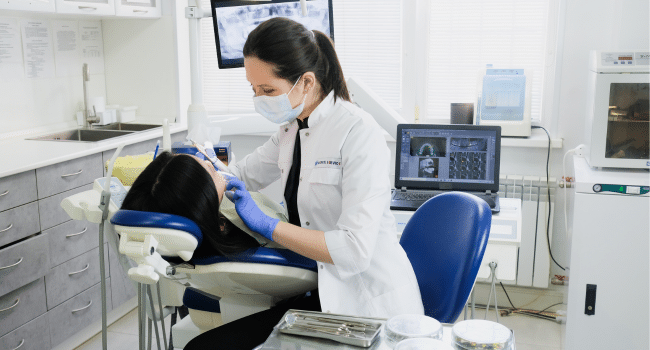Table of Contents
Modern dentists face increasing pressures from rising costs, more competition, and changes in the healthcare market. To stay competitive and profitable, many dentists have turned to dental electronic health record (EHR) software to help them maximize their efficiency and productivity.
This article will explore the benefits/advantages of using dental EHR software from a dentist’s perspective, discussing how it can improve practice workflow and boost profits in the long run. The information provided will enable you to make a knowledgeable decision.
Definition of Dental EHR Software
Dental Charting software is a digital system that helps dentists keep track of patient information and other data related to the practice. This includes patient records, appointment scheduling, billing and claims processing, treatment plans, imaging documents, and more. It can also provide insight into practice patterns and help improve workflow by streamlining administrative tasks so dentists can spend more time with patients.
Benefits of Adopting Dental EHR Software
-
Improved Efficiency
Dental practices can improve their efficiency and productivity using dental EHR software. This software streamlines administrative tasks like appointment scheduling and billing, giving dentists more time to focus on patient care.
-
Enhanced Patient Care
With access to complete patient records, including history and images, dentists can provide more informed, personalized care. This also makes it easy to maintain track of treatments and follow-up visits, resulting in better patient outcomes.
-
Improved Revenue Cycle
By automating billing and claims processing processes, dental EHR software can help streamline the revenue cycle while reducing administrative errors that could lead to lost revenue.
-
Increased Regulatory Compliance
Dental EHR software can help ensure practices comply with all relevant regulations and reduce the risk of penalties for non-compliance.
-
Improved Data Security
Dental EHR software can also improve data security by encrypting patient information, limiting access to authorized personnel only, and providing audit trails. This can help in protecting patient privacy and reduce the data breaches risk.
Maximizing Efficiency and Productivity with Dental EHR Software
-
Select the Right System
Selecting a system that can meet your needs and offers features that can help improve practice efficiency is important. Research various solutions and compare them based on cost, functionality, user experience, security measures, and customer service.
-
Set Clear Goals
Before transitioning to a new dental EHR system, set clear goals and objectives to help ensure a successful implementation. This should include identifying any areas of improvement in the practice and ways that the dental practice management software can help meet those needs.
-
Train Staff
To ensure optimal results from new technology, it is crucial to provide thorough staff training. Ensure that everyone knows the system well and is equipped with the necessary/right knowledge to operate it effectively.
-
Stay Up to Date
To maximize the benefits of your dental EHR software, it’s important to keep track of new updates and features. Doing this will help you know that the system operates efficiently and delivers more value to your practice.
-
Automation of Tasks
Automation of many administrative tasks can help reduce errors and improve accuracy. Examples include appointment scheduling, billing, claims processing, document management, etc.
-
Monitor Performance
Regularly monitor the performance of the dental EHR system to ensure it meets your business needs. This should include tracking important metrics such as revenue cycle management, patient satisfaction, and practice efficiency.
Conclusion
Dental EHR software can be a powerful tool to help dentists maximize efficiency and productivity while providing enhanced patient care. The key to success when implementing an electronic health records system is to select the right solution, set clear goals, train staff properly, stay updated with updates and features, and use automation tools. With the right system in place, dentists can streamline workflow and unlock the full potential of their practice.
Read more on KulFiy
How Serious is An Untreated Dental Abscess Emergency?
Most common Dental Problems person face in life
Dental problems that can trouble you a lot
